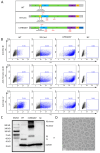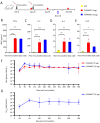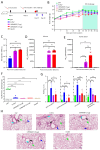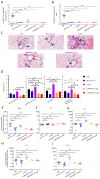An mRNA-Based Respiratory Syncytial Virus Vaccine Elicits Strong Neutralizing Antibody Responses and Protects Rodents Without Vaccine-Associated Enhanced Respiratory Disease
- PMID: 39852831
- PMCID: PMC11768429
- DOI: 10.3390/vaccines13010052
An mRNA-Based Respiratory Syncytial Virus Vaccine Elicits Strong Neutralizing Antibody Responses and Protects Rodents Without Vaccine-Associated Enhanced Respiratory Disease
Abstract
Background: Respiratory syncytial virus (RSV) causes the most common type of severe lower respiratory tract infection worldwide, and the fusion (F) protein is a target for neutralizing antibodies and vaccine development. This study aimed to investigate the immunogenicity and efficacy of an mRNA-based RSV vaccine with an F protein sequence.
Methods: We designed an mRNA construct encoding a modified RSV F protein, which was further developed into an LNP-encapsulated mRNA vaccine (LVRNA007). LVRNA007 was administered to mice and cotton rats, followed by immunogenicity analysis and viral challenge studies. Protection of rodents from the viral infection was evaluated based on the presence of the virus in the lung and pathological examination of respiratory tissues.
Results: LVRNA007 induced robust humoral and cellular immune responses in both mice and cotton rats, with neutralization antibody levels in the immunized animals maintained at high levels for over one year. Vaccination of LVRNA007 also protected the rodents from RSV challenge, judged by the much decreased virus titer and the pathological score in the lung tissue. In addition, no vaccine-enhanced disease (VED) phenomenon was observed with LVRNA007 vaccination.
Conclusions: Based on the preclinical immunogenicity and efficacy data, LVRNA007 could be a potential promising vaccine for prophylaxis of RSV infection.
Keywords: F protein; LVRNA007; RSV; mRNA vaccine; viral challenge study.
Conflict of interest statement
The authors declare no competing interests. All authors are employees of the company Liverna Therapeutics Inc., Zhuhai, Guangdong, China. Liverna Therapeutics Inc. had a role in the study design, data collection and interpretation, and the decision to submit the work for publication.
Figures





Similar articles
-
Respiratory syncytial virus fusion nanoparticle vaccine immune responses target multiple neutralizing epitopes that contribute to protection against wild-type and palivizumab-resistant mutant virus challenge.Vaccine. 2018 Dec 18;36(52):8069-8078. doi: 10.1016/j.vaccine.2018.10.073. Epub 2018 Oct 30. Vaccine. 2018. PMID: 30389195
-
A Single-Dose Recombinant Parainfluenza Virus 5-Vectored Vaccine Expressing Respiratory Syncytial Virus (RSV) F or G Protein Protected Cotton Rats and African Green Monkeys from RSV Challenge.J Virol. 2017 May 12;91(11):e00066-17. doi: 10.1128/JVI.00066-17. Print 2017 Jun 1. J Virol. 2017. PMID: 28298602 Free PMC article.
-
An insect cell derived respiratory syncytial virus (RSV) F nanoparticle vaccine induces antigenic site II antibodies and protects against RSV challenge in cotton rats by active and passive immunization.Vaccine. 2014 Nov 12;32(48):6485-92. doi: 10.1016/j.vaccine.2014.09.030. Epub 2014 Sep 28. Vaccine. 2014. PMID: 25269094 Free PMC article.
-
Alternative Virus-Like Particle-Associated Prefusion F Proteins as Maternal Vaccines for Respiratory Syncytial Virus.J Virol. 2019 Nov 13;93(23):e00914-19. doi: 10.1128/JVI.00914-19. Print 2019 Dec 1. J Virol. 2019. PMID: 31511382 Free PMC article.
-
Immunization with Low Doses of Recombinant Postfusion or Prefusion Respiratory Syncytial Virus F Primes for Vaccine-Enhanced Disease in the Cotton Rat Model Independently of the Presence of a Th1-Biasing (GLA-SE) or Th2-Biasing (Alum) Adjuvant.J Virol. 2017 Mar 29;91(8):e02180-16. doi: 10.1128/JVI.02180-16. Print 2017 Apr 15. J Virol. 2017. PMID: 28148790 Free PMC article.
Cited by
-
Structural biology of Nipah virus G and F glycoproteins: Insights into therapeutic and vaccine development.Eur J Microbiol Immunol (Bp). 2025 Apr 22;15(2):83-93. doi: 10.1556/1886.2025.00017. Print 2025 Jun 30. Eur J Microbiol Immunol (Bp). 2025. PMID: 40261700 Free PMC article. Review.
References
-
- Nguyen-Van-Tam J.S., O’Leary M., Martin E.T., Heijnen E., Callendret B., Fleischhackl R., Comeaux C., Tran T.M.P., Weber K. Burden of respiratory syncytial virus infection in older and high-risk adults: A systematic review and meta-analysis of the evidence from developed countries. Eur. Respir. Rev. 2022;31:220105. doi: 10.1183/16000617.0105-2022. - DOI - PMC - PubMed
-
- Li Y., Wang X., Blau D.M., Caballero M.T., Feikin D.R., Gill C.J., Madhi S.A., Omer S.B., Simoes E.A.F., Campbell H., et al. Global, regional, and national disease burden estimates of acute lower respiratory infections due to respiratory syncytial virus in children younger than 5 years in 2019: A systematic analysis. Lancet. 2022;399:2047–2064. doi: 10.1016/S0140-6736(22)00478-0. - DOI - PMC - PubMed
-
- Azzari C., Baraldi E., Bonanni P., Bozzola E., Coscia A., Lanari M., Manzoni P., Mazzone T., Sandri F., Checcucci Lisi G., et al. Epidemiology and prevention of respiratory syncytial virus infections in children in Italy. Ital. J. Pediatr. 2021;47:198. doi: 10.1186/s13052-021-01148-8. - DOI - PMC - PubMed
-
- Pellegrinelli L., Galli C., Bubba L., Cereda D., Anselmi G., Binda S., Gramegna M., Pariani E. Respiratory syncytial virus in influenza-like illness cases: Epidemiology and molecular analyses of four consecutive winter seasons (2014–2015/2017–2018) in Lombardy (Northern Italy) J. Med. Virol. 2020;92:2999–3006. doi: 10.1002/jmv.25917. - DOI - PubMed
LinkOut - more resources
Full Text Sources

